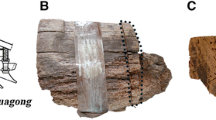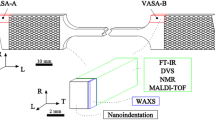Summary
The possibilities of interaction between wood, Pinus sylvestris, (60% RH) and potassium stained PEG 1500 (polyethyleneglycol) have been investigated using Scanning Electron Microscopy (EDS-analysis), dynamical mechanical techniques (DMTA) and X-ray diffraction (WAX).
The EDS-analysis shows an even distribution of potassium in the cell wall. On the other hand the predicted cell wall swelling associated with PEG absorption is absent. This indicates that the method of staining PEG with potassium does not work. The DMTA-measurements show interaction on the molecular level between wood and PEG 1500. EDS-analysis, SEM- and WAX-investigations show free PEG in the impregnated specimens.
Similar content being viewed by others
References
Akitsu, H.; Norimoto, M.; Morooka, T. 1991: Vibrational properties of chemically modified wood. Mokuzai Gakkaishi. 37: 590–597
Banks, W. B. 1971: The role of water repellents in the protection of timber. In Br. Wood Preservation Association Annual Convention: 129–147
Banks, W. B. 1980: The performance of water repellents in the control of moisture absorbtion by wood exposed to the weather, Br. Wood Preservation Association Annual Convention: 43–53
Boutelje, J. 1962: On shrinkage and change in microscopic void volume during drying, as calculated from measurements on microtome cross sections of Swedish Pine. (Pinus Sylvestris L.) Svensk Papperstidn. 65: 209–215
Dinwoodie, J. M. (Ed.): 1981: In: Timber, its nature and behaviour, pp 19, New York: Van Noostrand Reinhold
Faucher, J. A.; Koleske, J. V.; Santee, Jr, E. R.; Stratta, J. J.; Wilson, C. W. 1966: Glass Transitions of Ethylene Oxide Polymers. J. of Appl. Physics. 37: 3962–3964
Feist, W. C.; Mraz, E. A. 1978: Comparison of outdoor and accelerated weathering of unprotected softwoods. Forest Prod. J. 28: 38–43
Feist, W. C.; Hon, D. N.-S. 1984: Chemistry of weathering and protection. In: Rowell, R. M. (Ed.): The chemistry of solid wood. Advances in chemistry series. Nr 207, pp 401–451, Washington: American Chemical Society
Fengel, D.; Wegener, G. (Ed.): 1984: In: Wood. Chemistry ultrastructure and reactions, pp 12. New York; de Gruyter
Finney, R. W.; Jones, A. M. 1993: Direct analysis of wood preservatives in ancient oak from the Mary Rose by laser microprobe mass spectrometry. Studies in Conservations: 38: 36–44
Florian, M-L. E. 1990: Scope and history of archaeological wood. In: Rowell, R. M.; Barbour, R. J. (Ed.): Archaeological wood: Properties, chemistry, and preservation. Advances in Chemistry Series. Nr 225, pp 22, Washington: American Chemical Society
Flory, P. J. (Ed.): 1953: Principles of Polymer Chemistry, pp 611, London: Cornell University Press
Handa, T.; Fukuoka, M.; Yoshizawa, S.; Hashizume, Y.; Suzuki, M. 1980: The dielectric properties of wood and wood-polymer composite (WPC) containing moisture at low temperature regions. In: Proc from the 23rd Japan Congress of Materials Research-Non Metallic Materials, pp 338–343
Håfors, B. 1990: The role of the Wasa in the development of the polyethylene glycol preservation method. In: Rowell, R. M.; Barbour, R. J. (Ed.): Archaeological wood: Properties, chemistry, and preservation. Advances in Chemistry Series. Nr 225, pp 195–216, Washington: American Chemical Society
Kaplan, D. S. 1976: Structure-property relationships in copolymers to composites: Molecular interpretation of the glass transition phenomenon. J. of Appl. Polymer Sci. 20: 2615–2629
Moré n, R. E. 1968: Some practical applications of polyethylene glycol for the stabilization and preservation of wood. Technical report. Nr 82, pp 42, Mo och Domsjö AB, Örnsköldsvik: Chemical Application an Technical Service Department
Morooka, T.; Akitsu, H.; Norimoto, M. 1991: Dynamic mechanical properties of chemically modified wood. In: Proc of the Int. Symp on Chemical modification of wood. Kyoto, Japan, pp 92–97
Rowell, R. M. 1990: Chemical modification of cell wall polymers as potential treatments of archaeological wood. In: Rowell, R. M.; Barbour, R. J. (Ed.): Archaeological wood: Properties, chemistry, and preservation. Advances in Chemistry Series. Nr 225, pp 421–431. Washington: American Chemical Society
Sell, J. 1977: Hydrophobierende Holzimprägnierung-Wirkungsweise, Eigenschaften, Anwendungsmöglichkeiten, Holz Werkstoff 35: 75–78
Stamm, A. J. 1977: Dimensional changes in wood and their control. In: Goldstein, I. S. (Ed.): Wood technology: Chemical Aspects. ACS Symposium Series 43. pp 114–149, Washington: American Chemical Society
Tarkow, H.; Feist, W. C.; Southerland, C. F. 1966: Interaction of wood with polymeric materials, penetration versus molecular size. Forest Products Journal. 16: 61–65
Author information
Authors and Affiliations
Rights and permissions
About this article
Cite this article
Wallström, L., Lindberg, K.A.H. Wood surface stabilization with polyethyleneglycol, PEG. Wood Sci.Technol. 29, 109–119 (1995). https://doi.org/10.1007/BF00229340
Received:
Issue Date:
DOI: https://doi.org/10.1007/BF00229340




